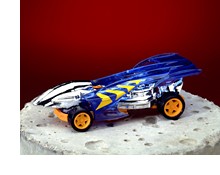|
Mattel
|
In the toy industry, the difference between a "hit" and a "miss" is often determined by who
can get their products to retail first. It is in this race to the marketplace that Mattel, Inc.
has found an indispensable ally in stereolithography.
"The only way we were able to deliver production quality products in time for the New York Toy Fair was by using SL."
- Dave Carmen, Director, Product Engineering, Mattel, Inc
|

|
The Challenge
The American International Toy Fair, a make-or-break event for toy makers, loomed on the horizon a short five months away. Mattel's project designers were tasked with the challenge of developing a new line of Hot Wheels that would emulate the popularity Barbie has enjoyed with young consumers for years. The result -- TOP SPEED PIPEJAMMERS.
Unlike anything Mattel's HOT WHEELS designers had ever attempted, the six ultra-light, high-tech TOP SPEED PIPEJAMMERS featured radically different design and development components, including a detailed engine, floating front axle and a translucent plastic body.
With the toy fair only three months away, the project appeared to be on-schedule. That is, until Mattel's manufacturing engineers said that the planned translucent wheels would require drastic retooling at the company's plant. For the designers, this meant new wheels and new prototypes. Conventional methods would require $15,000 and 3 weeks to create. With time and money being critical resources, Mattel's designers turned to the stereolithography (SL) team for assistance.
The Results
While the cars may be fast, they don't come close to matching the speed of the stereolithography team. Thanks to SL technology, new models were provided within 24 hours. In addition to vital time savings, the actual stereolithography models were more precise and less expensive to produce than similar models previously created. In fact, this was the first Mattel product line to rely solely on SL master patterns during the final stages of its development process.
By February, stereolithography "masters" of the vehicles were painted and ready for display at the toy fair when Top SPEED PIPEJAMMERS made their official debut for customers and members of the media. The new line of cars were instantly declared a "hit" and attracted significant media attention.
By adding stereolithography to the "pit crew's" resources, Mattel:
- Decreased time-to-market by 20 percent
- Realized a significant cost savings of $14,500 per prototype
- Accelerated their prototype development cycle from 3-4 weeks to 2-3 days
- Provided their designers with assurance that design integrity would be fully retained, including highly intricate detail never before attempted in the HOT WHEELS product line
- Released production molds in a record eight months for plastic injection molding of 200,000 models of each vehicle
- Performed what could quite possibly be one of the biggest product launches ever in terms of demand
The Process
Mattel first modeled the design in Alias 3-D CAD. Stereolithography models were then built in two sizes: an exact size replica for verification, and a "3-up" pattern, three times the size of the actual car. Once the SL master was complete, tooling detail was applied to the scaled-up model with wax and Mattel proceeded to a process called pantographing.
The result of the pantographing process is a master tool. The SL 3-up pattern was mounted on a follow-board and a parting plane physically defined by the craftsman. The follow-board was then cast in hard epoxy, squared up on the sides about 4 inches thick. After removing the follow-board, the epoxy negative of the stereolithography pattern was placed on the pantograph.
A pantograph has two arms: one containing a small stylus which traces the epoxy mold, the other a cutting stylus which hogs out a metal mold scaled down to the actual size of the Hot Wheels car. By tracing the 3-up epoxy negative, Mattel was able to capture the intricate detail of the TOP SPEED PIPEJAMMERS in original-scale metal molds. The aluminum molds generated by this process are good for plastic injection molding of 10 to 1,000 parts. For this critical project, two first article models were generated in time for the Toy Fair. Four handpainted SL "masters" completed the suite of cars showcased at the expo. Steel production molds for the entire TOP SPEED PIPEJAMMERS product line were subsequently produced through the same SL and pantographing process.
The Tools
- Alias 3-D CAD software
- SLA 250/30 with Cibatool SL 5170 resin
- Deckel Pantograph
Company Profile
Mattel, Inc. is a worldwide leader in the design, manufacture and marketing of children's toys. With headquarters in El Segundo, California, Mattel has offices and facilities in 34 countries and sells its products in more than 140 nations throughout the world.
Mattel entered the rapid prototyping arena in 1993 with a leased SLA 250/30. So great was their utilization of this system that the company purchased the larger SLA 500/20 less than a year later generating 370 prototype parts in its first month alone. Today, their SLA 500 operates seven days a week, 24 hours a day to keep up with the design demands of this international toy giant.
|



